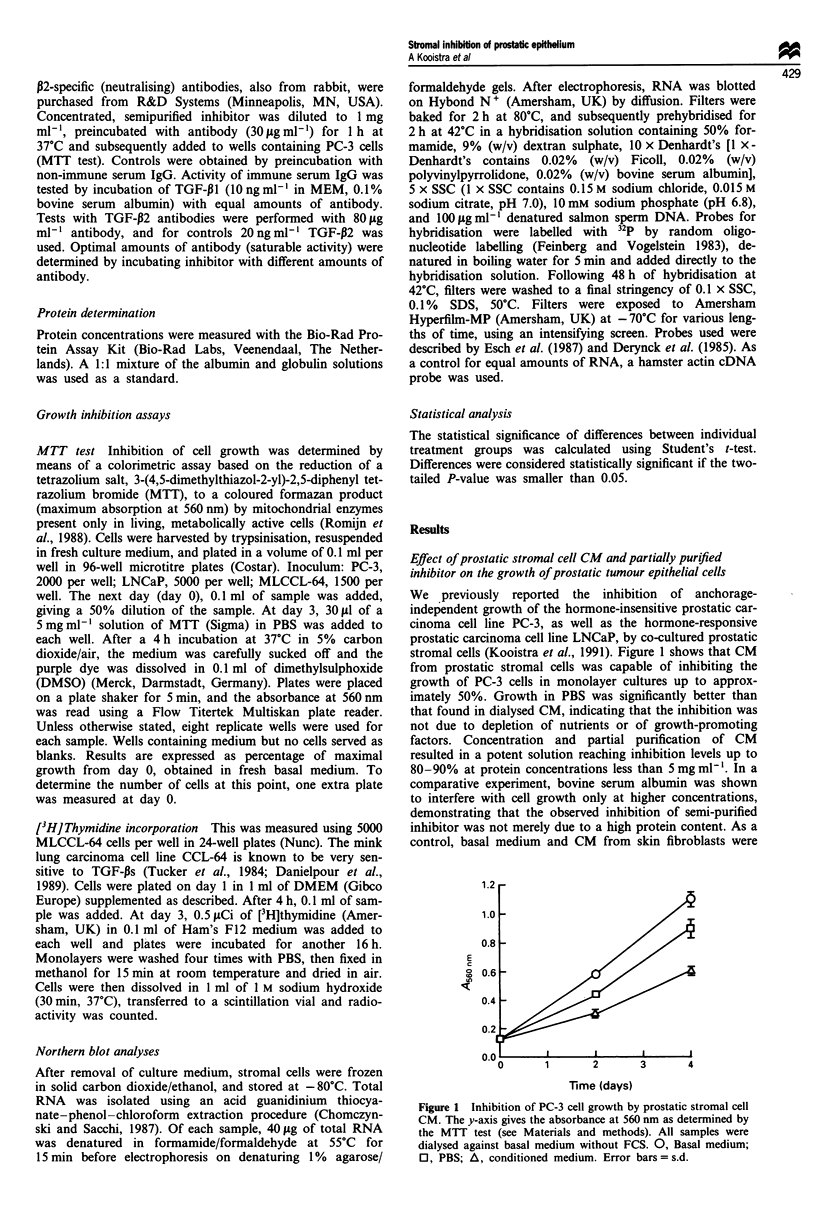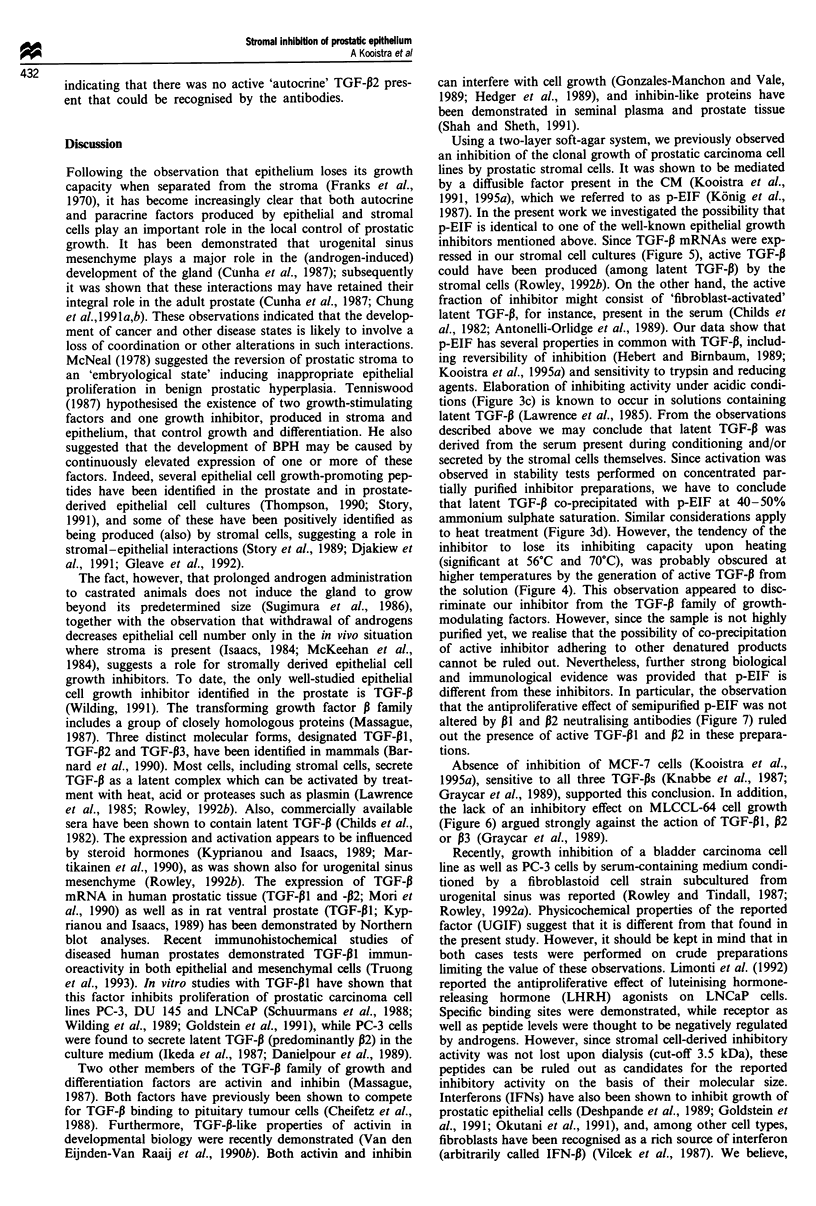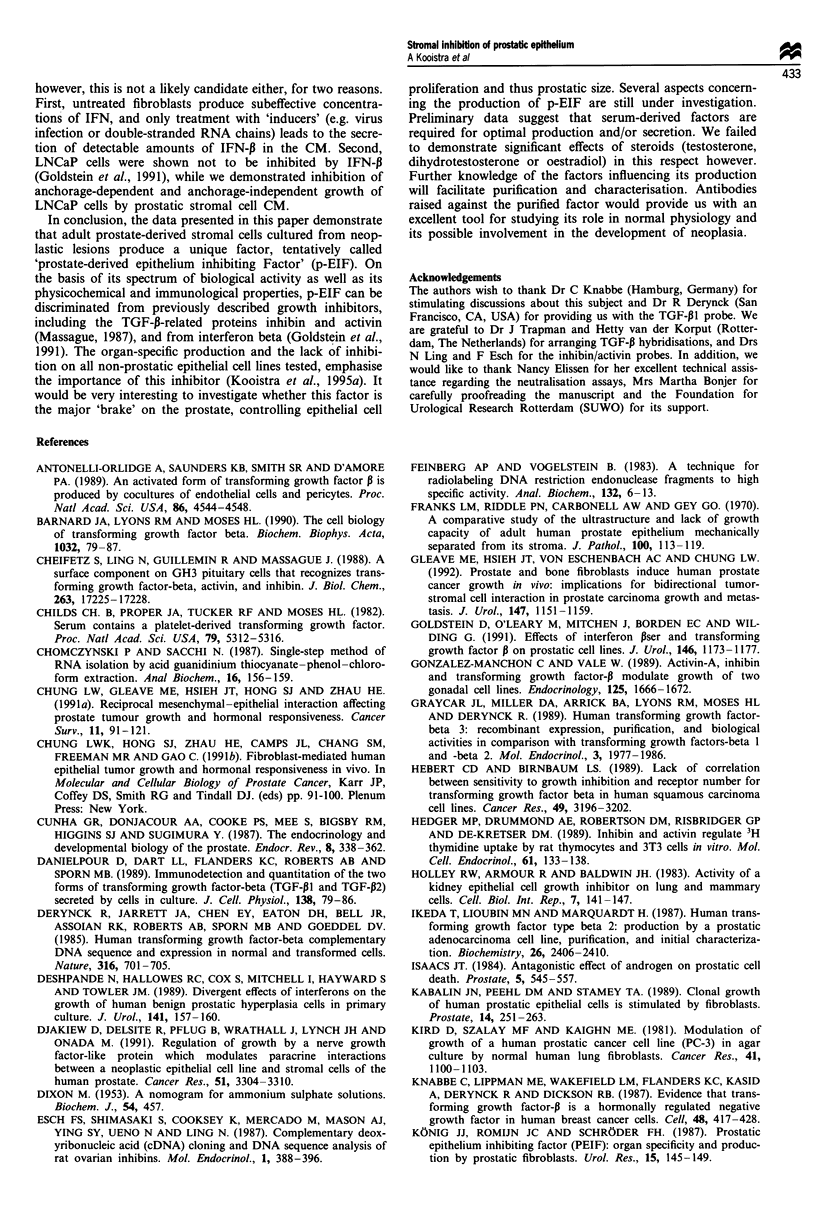Abstract
The paracrine influence of prostatic stroma on the proliferation of prostatic epithelial cells was investigated. Stromal cells from the human prostate have previously been shown to inhibit anchorage-dependent as well as anchorage-independent growth of the prostatic tumour epithelial cell lines PC-3 and LNCaP. Antiproliferative activity, mediated by a diffusible factor in the stromal cell conditioned medium, was found to be produced specifically by prostatic stromal cells. In the present study the characteristics of this factor were examined. It is demonstrated that prostate stroma-derived inhibiting factor is an acid- and heat-labile, dithiothreitol-sensitive protein. Although some similarities with type beta transforming growth factor (TGF-beta)-like inhibitors are apparent, evidence is presented that the factor is not identical to TGF-beta or to the TGF-beta-like factors activin and inhibin. Absence of TGF-beta activity was shown by the lack of inhibitory response of the TGF-beta-sensitive mink lung cell line CCL-64 to prostate stromal cell conditioned medium and to concentrated, partially purified preparations of the inhibitor. Furthermore, neutralising antibodies against TGF-beta 1 or TGF-beta 2 did not cause a decline in the level of PC-3 growth inhibition caused by partially purified inhibitor. Using Northern blot analyses, we excluded the involvement of inhibin or activin. It is concluded that the prostate stroma-derived factor may be a novel growth inhibitor different from any of the currently described inhibiting factors.
Full text
PDF







Images in this article
Selected References
These references are in PubMed. This may not be the complete list of references from this article.
- Antonelli-Orlidge A., Saunders K. B., Smith S. R., D'Amore P. A. An activated form of transforming growth factor beta is produced by cocultures of endothelial cells and pericytes. Proc Natl Acad Sci U S A. 1989 Jun;86(12):4544–4548. doi: 10.1073/pnas.86.12.4544. [DOI] [PMC free article] [PubMed] [Google Scholar]
- Barnard J. A., Lyons R. M., Moses H. L. The cell biology of transforming growth factor beta. Biochim Biophys Acta. 1990 Jun 1;1032(1):79–87. doi: 10.1016/0304-419x(90)90013-q. [DOI] [PubMed] [Google Scholar]
- Cheifetz S., Ling N., Guillemin R., Massagué J. A surface component on GH3 pituitary cells that recognizes transforming growth factor-beta, activin, and inhibin. J Biol Chem. 1988 Nov 25;263(33):17225–17228. [PubMed] [Google Scholar]
- Childs C. B., Proper J. A., Tucker R. F., Moses H. L. Serum contains a platelet-derived transforming growth factor. Proc Natl Acad Sci U S A. 1982 Sep;79(17):5312–5316. doi: 10.1073/pnas.79.17.5312. [DOI] [PMC free article] [PubMed] [Google Scholar]
- Chomczynski P., Sacchi N. Single-step method of RNA isolation by acid guanidinium thiocyanate-phenol-chloroform extraction. Anal Biochem. 1987 Apr;162(1):156–159. doi: 10.1006/abio.1987.9999. [DOI] [PubMed] [Google Scholar]
- Chung L. W., Gleave M. E., Hsieh J. T., Hong S. J., Zhau H. E. Reciprocal mesenchymal-epithelial interaction affecting prostate tumour growth and hormonal responsiveness. Cancer Surv. 1991;11:91–121. [PubMed] [Google Scholar]
- Cunha G. R., Donjacour A. A., Cooke P. S., Mee S., Bigsby R. M., Higgins S. J., Sugimura Y. The endocrinology and developmental biology of the prostate. Endocr Rev. 1987 Aug;8(3):338–362. doi: 10.1210/edrv-8-3-338. [DOI] [PubMed] [Google Scholar]
- DIXON M. A nomogram for ammonium sulphate solutions. Biochem J. 1953 Jun;54(3):457–458. doi: 10.1042/bj0540457. [DOI] [PMC free article] [PubMed] [Google Scholar]
- Danielpour D., Dart L. L., Flanders K. C., Roberts A. B., Sporn M. B. Immunodetection and quantitation of the two forms of transforming growth factor-beta (TGF-beta 1 and TGF-beta 2) secreted by cells in culture. J Cell Physiol. 1989 Jan;138(1):79–86. doi: 10.1002/jcp.1041380112. [DOI] [PubMed] [Google Scholar]
- Derynck R., Jarrett J. A., Chen E. Y., Eaton D. H., Bell J. R., Assoian R. K., Roberts A. B., Sporn M. B., Goeddel D. V. Human transforming growth factor-beta complementary DNA sequence and expression in normal and transformed cells. Nature. 1985 Aug 22;316(6030):701–705. doi: 10.1038/316701a0. [DOI] [PubMed] [Google Scholar]
- Deshpande N., Hallowes R. C., Cox S., Mitchell I., Hayward S., Towler J. M. Divergent effects of interferons on the growth of human benign prostatic hyperplasia cells in primary culture. J Urol. 1989 Jan;141(1):157–160. doi: 10.1016/s0022-5347(17)40631-8. [DOI] [PubMed] [Google Scholar]
- Djakiew D., Delsite R., Pflug B., Wrathall J., Lynch J. H., Onoda M. Regulation of growth by a nerve growth factor-like protein which modulates paracrine interactions between a neoplastic epithelial cell line and stromal cells of the human prostate. Cancer Res. 1991 Jun 15;51(12):3304–3310. [PubMed] [Google Scholar]
- Esch F. S., Shimasaki S., Cooksey K., Mercado M., Mason A. J., Ying S. Y., Ueno N., Ling N. Complementary deoxyribonucleic acid (cDNA) cloning and DNA sequence analysis of rat ovarian inhibins. Mol Endocrinol. 1987 May;1(5):388–396. doi: 10.1210/mend-1-5-388. [DOI] [PubMed] [Google Scholar]
- Feinberg A. P., Vogelstein B. A technique for radiolabeling DNA restriction endonuclease fragments to high specific activity. Anal Biochem. 1983 Jul 1;132(1):6–13. doi: 10.1016/0003-2697(83)90418-9. [DOI] [PubMed] [Google Scholar]
- Franks L. M., Riddle P. N., Carbonell A. W., Gey G. O. A comparative study of the ultrastructure and lack of growth capacity of adult human prostate epithelium mechanically separated from its stroma. J Pathol. 1970 Feb;100(2):113–119. doi: 10.1002/path.1711000206. [DOI] [PubMed] [Google Scholar]
- Gleave M. E., Hsieh J. T., von Eschenbach A. C., Chung L. W. Prostate and bone fibroblasts induce human prostate cancer growth in vivo: implications for bidirectional tumor-stromal cell interaction in prostate carcinoma growth and metastasis. J Urol. 1992 Apr;147(4):1151–1159. doi: 10.1016/s0022-5347(17)37506-7. [DOI] [PubMed] [Google Scholar]
- Goldstein D., O'Leary M., Mitchen J., Borden E. C., Wilding G. Effects of interferon beta ser and transforming growth factor beta on prostatic cell lines. J Urol. 1991 Oct;146(4):1173–1177. doi: 10.1016/s0022-5347(17)38034-5. [DOI] [PubMed] [Google Scholar]
- Gonzalez-Manchon C., Vale W. Activin-A, inhibin and transforming growth factor-beta modulate growth of two gonadal cell lines. Endocrinology. 1989 Sep;125(3):1666–1672. doi: 10.1210/endo-125-3-1666. [DOI] [PubMed] [Google Scholar]
- Graycar J. L., Miller D. A., Arrick B. A., Lyons R. M., Moses H. L., Derynck R. Human transforming growth factor-beta 3: recombinant expression, purification, and biological activities in comparison with transforming growth factors-beta 1 and -beta 2. Mol Endocrinol. 1989 Dec;3(12):1977–1986. doi: 10.1210/mend-3-12-1977. [DOI] [PubMed] [Google Scholar]
- Hedger M. P., Drummond A. E., Robertson D. M., Risbridger G. P., de Kretser D. M. Inhibin and activin regulate [3H]thymidine uptake by rat thymocytes and 3T3 cells in vitro. Mol Cell Endocrinol. 1989 Jan;61(1):133–138. doi: 10.1016/0303-7207(89)90198-6. [DOI] [PubMed] [Google Scholar]
- Holley R. W., Armour R., Baldwin J. H., Greenfield S. Activity of a kidney epithelial cell growth inhibitor on lung and mammary cells. Cell Biol Int Rep. 1983 Feb;7(2):141–147. doi: 10.1016/0309-1651(83)90027-9. [DOI] [PubMed] [Google Scholar]
- Hébert C. D., Birnbaum L. S. Lack of correlation between sensitivity to growth inhibition and receptor number for transforming growth factor beta in human squamous carcinoma cell lines. Cancer Res. 1989 Jun 15;49(12):3196–3202. [PubMed] [Google Scholar]
- Ikeda T., Lioubin M. N., Marquardt H. Human transforming growth factor type beta 2: production by a prostatic adenocarcinoma cell line, purification, and initial characterization. Biochemistry. 1987 May 5;26(9):2406–2410. doi: 10.1021/bi00383a002. [DOI] [PubMed] [Google Scholar]
- Isaacs J. T. Antagonistic effect of androgen on prostatic cell death. Prostate. 1984;5(5):545–557. doi: 10.1002/pros.2990050510. [DOI] [PubMed] [Google Scholar]
- Kabalin J. N., Peehl D. M., Stamey T. A. Clonal growth of human prostatic epithelial cells is stimulated by fibroblasts. Prostate. 1989;14(3):251–263. doi: 10.1002/pros.2990140306. [DOI] [PubMed] [Google Scholar]
- Kirk D., Szalay M. F., Kaighn M. E. Modulation of growth of a human prostatic cancer cell line (PC-3) in agar culture by normal human lung fibroblasts. Cancer Res. 1981 Mar;41(3):1100–1103. [PubMed] [Google Scholar]
- Knabbe C., Lippman M. E., Wakefield L. M., Flanders K. C., Kasid A., Derynck R., Dickson R. B. Evidence that transforming growth factor-beta is a hormonally regulated negative growth factor in human breast cancer cells. Cell. 1987 Feb 13;48(3):417–428. doi: 10.1016/0092-8674(87)90193-0. [DOI] [PubMed] [Google Scholar]
- Kooistra A., König J. J., Keizer D. M., Romijn J. C., Schröder F. H. Inhibition of prostatic epithelial cell proliferation by a factor secreted specifically by prostatic stromal cells. Prostate. 1995 Mar;26(3):123–132. doi: 10.1002/pros.2990260304. [DOI] [PubMed] [Google Scholar]
- Kooistra A., König J. J., Romijn J. C., Schröder F. H. Negative control of epithelial cell proliferation by prostatic stroma. Anticancer Res. 1991 Jul-Aug;11(4):1495–1500. [PubMed] [Google Scholar]
- Kyprianou N., Isaacs J. T. Expression of transforming growth factor-beta in the rat ventral prostate during castration-induced programmed cell death. Mol Endocrinol. 1989 Oct;3(10):1515–1522. doi: 10.1210/mend-3-10-1515. [DOI] [PubMed] [Google Scholar]
- König J. J., Romijn J. C., Schröder F. H. Prostatic epithelium inhibiting factor (PEIF): organ specificity and production by prostatic fibroblasts. Urol Res. 1987;15(3):145–149. doi: 10.1007/BF00254426. [DOI] [PubMed] [Google Scholar]
- Lawrence D. A., Pircher R., Jullien P. Conversion of a high molecular weight latent beta-TGF from chicken embryo fibroblasts into a low molecular weight active beta-TGF under acidic conditions. Biochem Biophys Res Commun. 1985 Dec 31;133(3):1026–1034. doi: 10.1016/0006-291x(85)91239-2. [DOI] [PubMed] [Google Scholar]
- Limonta P., Dondi D., Moretti R. M., Maggi R., Motta M. Antiproliferative effects of luteinizing hormone-releasing hormone agonists on the human prostatic cancer cell line LNCaP. J Clin Endocrinol Metab. 1992 Jul;75(1):207–212. doi: 10.1210/jcem.75.1.1320049. [DOI] [PubMed] [Google Scholar]
- Martikainen P., Kyprianou N., Isaacs J. T. Effect of transforming growth factor-beta 1 on proliferation and death of rat prostatic cells. Endocrinology. 1990 Dec;127(6):2963–2968. doi: 10.1210/endo-127-6-2963. [DOI] [PubMed] [Google Scholar]
- Massagué J. The TGF-beta family of growth and differentiation factors. Cell. 1987 May 22;49(4):437–438. doi: 10.1016/0092-8674(87)90443-0. [DOI] [PubMed] [Google Scholar]
- McKeehan W. L., Adams P. S. Heparin-binding growth factor/prostatropin attenuates inhibition of rat prostate tumor epithelial cell growth by transforming growth factor type beta. In Vitro Cell Dev Biol. 1988 Mar;24(3):243–246. doi: 10.1007/BF02623554. [DOI] [PubMed] [Google Scholar]
- McKeehan W. L., Adams P. S., Rosser M. P. Direct mitogenic effects of insulin, epidermal growth factor, glucocorticoid, cholera toxin, unknown pituitary factors and possibly prolactin, but not androgen, on normal rat prostate epithelial cells in serum-free, primary cell culture. Cancer Res. 1984 May;44(5):1998–2010. [PubMed] [Google Scholar]
- McNeal J. E. Origin and evolution of benign prostatic enlargement. Invest Urol. 1978 Jan;15(4):340–345. [PubMed] [Google Scholar]
- Meunier H., Rivier C., Evans R. M., Vale W. Gonadal and extragonadal expression of inhibin alpha, beta A, and beta B subunits in various tissues predicts diverse functions. Proc Natl Acad Sci U S A. 1988 Jan;85(1):247–251. doi: 10.1073/pnas.85.1.247. [DOI] [PMC free article] [PubMed] [Google Scholar]
- Mori H., Maki M., Oishi K., Jaye M., Igarashi K., Yoshida O., Hatanaka M. Increased expression of genes for basic fibroblast growth factor and transforming growth factor type beta 2 in human benign prostatic hyperplasia. Prostate. 1990;16(1):71–80. doi: 10.1002/pros.2990160108. [DOI] [PubMed] [Google Scholar]
- Nishi N., Matuo Y., Nakamoto T., Wada F. Proliferation of epithelial cells derived from rat dorsolateral prostate in serum-free primary cell culture and their response to androgen. In Vitro Cell Dev Biol. 1988 Aug;24(8):778–786. doi: 10.1007/BF02623648. [DOI] [PubMed] [Google Scholar]
- Okutani T., Nishi N., Kagawa Y., Takasuga H., Takenaka I., Usui T., Wada F. Role of cyclic AMP and polypeptide growth regulators in growth inhibition by interferon in PC-3 cells. Prostate. 1991;18(1):73–80. doi: 10.1002/pros.2990180107. [DOI] [PubMed] [Google Scholar]
- Peehl D. M., Stamey T. A. Serum-free growth of adult human prostatic epithelial cells. In Vitro Cell Dev Biol. 1986 Feb;22(2):82–90. doi: 10.1007/BF02623537. [DOI] [PubMed] [Google Scholar]
- Romijn J. C., Verkoelen C. F., Schroeder F. H. Application of the MTT assay to human prostate cancer cell lines in vitro: establishment of test conditions and assessment of hormone-stimulated growth and drug-induced cytostatic and cytotoxic effects. Prostate. 1988;12(1):99–110. doi: 10.1002/pros.2990120112. [DOI] [PubMed] [Google Scholar]
- Rowley D. R. Characterization of a fetal urogenital sinus mesenchymal cell line U4F: secretion of a negative growth regulatory activity. In Vitro Cell Dev Biol. 1992 Jan;28A(1):29–38. doi: 10.1007/BF02631077. [DOI] [PubMed] [Google Scholar]
- Rowley D. R. Glucocorticoid regulation of transforming growth factor-beta activation in urogenital sinus mesenchymal cells. Endocrinology. 1992 Jul;131(1):471–478. doi: 10.1210/endo.131.1.1612028. [DOI] [PubMed] [Google Scholar]
- Rowley D. R., Tindall D. J. Responses of NBT-II bladder carcinoma cells to conditioned medium from normal fetal urogenital sinus. Cancer Res. 1987 Jun 1;47(11):2955–2960. [PubMed] [Google Scholar]
- Schuurmans A. L., Bolt J., Mulder E. Androgens and transforming growth factor beta modulate the growth response to epidermal growth factor in human prostatic tumor cells (LNCaP). Mol Cell Endocrinol. 1988 Nov;60(1):101–104. doi: 10.1016/0303-7207(88)90124-4. [DOI] [PubMed] [Google Scholar]
- Sherwood E. R., Fong C. J., Lee C., Kozlowski J. M. Basic fibroblast growth factor: a potential mediator of stromal growth in the human prostate. Endocrinology. 1992 May;130(5):2955–2963. doi: 10.1210/endo.130.5.1374018. [DOI] [PubMed] [Google Scholar]
- Silbermann M. H., Stuiver P. C. Het fenomeen van de uitgestelde eerste aanval van malaria tertiana. Ned Tijdschr Geneeskd. 1992 Oct 3;136(40):1984–1987. [PubMed] [Google Scholar]
- Story M. T., Livingston B., Baeten L., Swartz S. J., Jacobs S. C., Begun F. P., Lawson R. K. Cultured human prostate-derived fibroblasts produce a factor that stimulates their growth with properties indistinguishable from basic fibroblast growth factor. Prostate. 1989;15(4):355–365. doi: 10.1002/pros.2990150408. [DOI] [PubMed] [Google Scholar]
- Story M. T. Polypeptide modulators of prostatic growth and development. Cancer Surv. 1991;11:123–146. [PubMed] [Google Scholar]
- Sugimura Y., Cunha G. R., Donjacour A. A. Morphological and histological study of castration-induced degeneration and androgen-induced regeneration in the mouse prostate. Biol Reprod. 1986 Jun;34(5):973–983. doi: 10.1095/biolreprod34.5.973. [DOI] [PubMed] [Google Scholar]
- Tenniswood M. Role of epithelial-stromal interactions in the control of gene expression in the prostate: an hypothesis. Prostate. 1986;9(4):375–385. doi: 10.1002/pros.2990090407. [DOI] [PubMed] [Google Scholar]
- Thompson T. C. Growth factors and oncogenes in prostate cancer. Cancer Cells. 1990 Nov;2(11):345–354. [PubMed] [Google Scholar]
- Thompson T. C., Truong L. D., Timme T. L., Kadmon D., McCune B. K., Flanders K. C., Scardino P. T., Park S. H. Transforming growth factor beta 1 as a biomarker for prostate cancer. J Cell Biochem Suppl. 1992;16H:54–61. doi: 10.1002/jcb.240501212. [DOI] [PubMed] [Google Scholar]
- Tucker R. F., Shipley G. D., Moses H. L., Holley R. W. Growth inhibitor from BSC-1 cells closely related to platelet type beta transforming growth factor. Science. 1984 Nov 9;226(4675):705–707. doi: 10.1126/science.6093254. [DOI] [PubMed] [Google Scholar]
- Van den Eijnden-Van Raaij A. J., Koornneef I., Slager H. G., Mummery C. L., Van Zoelen E. J. Characterization of polyclonal anti-peptide antibodies specific for transforming growth factor beta 2. J Immunol Methods. 1990 Oct 4;133(1):107–118. doi: 10.1016/0022-1759(90)90324-o. [DOI] [PubMed] [Google Scholar]
- Vilcek J., Kohase M., Henriksen-DeStefano D. Mitogenic effect of double-stranded RNA in human fibroblasts: role of autogenous interferon. J Cell Physiol. 1987 Jan;130(1):37–43. doi: 10.1002/jcp.1041300107. [DOI] [PubMed] [Google Scholar]
- Wilding G. Response of prostate cancer cells to peptide growth factors: transforming growth factor-beta. Cancer Surv. 1991;11:147–163. [PubMed] [Google Scholar]
- Wilding G., Zugmeier G., Knabbe C., Flanders K., Gelmann E. Differential effects of transforming growth factor beta on human prostate cancer cells in vitro. Mol Cell Endocrinol. 1989 Mar;62(1):79–87. doi: 10.1016/0303-7207(89)90115-9. [DOI] [PubMed] [Google Scholar]
- van den Eijnden-Van Raaij A. J., van Zoelent E. J., van Nimmen K., Koster C. H., Snoek G. T., Durston A. J., Huylebroeck D. Activin-like factor from a Xenopus laevis cell line responsible for mesoderm induction. Nature. 1990 Jun 21;345(6277):732–734. doi: 10.1038/345732a0. [DOI] [PubMed] [Google Scholar]



